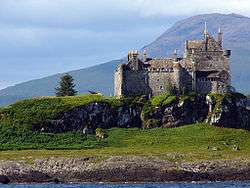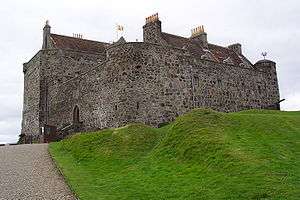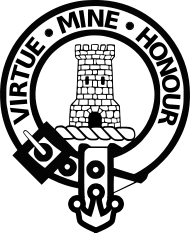Duart Castle
Duart Castle, or Caisteal Dhubhairt in Scottish Gaelic, is a castle on the Isle of Mull, off the west coast of Scotland, within the council area of Argyll and Bute. The castle dates back to the 13th century and is the seat of Clan MacLean.[1]


| Clan Maclean Clan Maclaine |
|---|
 |
| Branches |
|
| Lands |
| Castles |
| Septs |
History
Duart Castle was probably built by Clan MacDougall in the 13th century, and appears to have come into the hands of Clan MacLean in the following century.[2]
In 1350 Lachlan Lubanach Maclean of Duart, the 5th Clan Chief, married Mary, daughter of John of Islay, Lord of the Isles and Duart was part of her dowry.[3]
In 1647, Duart Castle was attacked and laid siege to by the Argyll government troops of Clan Campbell, but they were defeated and driven off by the Royalist troops of Clan MacLean.
In September 1653, a Cromwellian task force of six ships anchored off the castle, but the Macleans had already fled to Tiree. A storm blew up on the 13 September and three ships were lost, including HMS Swan. To the north of the castle is a Historic Marine Protected Area within which lie the remains of a wrecked 17th century warship, believed to be the Swan.[4]
In 1678, Archibald Campbell, 9th Earl of Argyll, son of the Marquess of Argyll, successfully invaded the Clan MacLean lands on the Isle of Mull and Sir John Maclean, 4th Baronet fled the castle and withdrew to Cairnbulg Castle, and afterward to Kintail under the protection of the Earl of Seaforth.[5]
In 1691 Duart Castle was surrendered by Sir John Maclean, 4th Baronet to Archibald Campbell, 1st Duke of Argyll.[1] The Campbell clan demolished the castle, and the stones from the walls were scattered. Donald Maclean, 5th Laird of Torloisk used some of the stones to build a cottage for his family close to the site of the castle.[6]
By 1751 the remains of the castle were abandoned.[7]
Descendants of Archibald Campbell, 1st Duke of Argyll sold the castle in 1801, to MacQuarrie, who then sold it to Carter-Campbell of Possil who kept it as a ruin within the grounds of his own estate to the north, Torosay Castle. He later sold his Torosay Estate which now included the ruins of Castle Duart to A. C. Guthrie in 1865. On 11 September 1911, the ruin was separated from the rest of the Torosay Estate and was bought by Sir Fitzroy Donald Maclean, the 26th Chief of the Clan MacLean and restored.[1][8][9]
Lairds of Duart
- Lairds are owners of an estate
- Lachlan Lubanach Maclean, 5th Chief, 1st laird of Duart, it was part of his wife's dowry.[3]
- Red Hector of the Battles Maclean, 6th Chief, 2nd laird of Duart.
- Lachlan Bronneach Maclean, 7th Chief, 3rd laird of Duart.
- Lachlan Og Maclean, 8th Chief, 4th laird of Duart.
- Hector Odhar Maclean, 9th Chief, 5th laird of Duart.
- Lachlan Maclean, 10th Chief, 6th laird of Duart.
- Lachlan Cattanach Maclean, 11th Chief, 7th laird of Duart.
- Hector Mor Maclean, 12th Chief (1497–1568), 8th laird of Duart.
- Hector Og Maclean, 13th Chief, 9th laird of Duart.
- Lachlan Mor Maclean, 14th Chief, 10th laird of Duart.
- Sir Hector Og Maclean, 15th Chief, 11th laird of Duart.
...
- Sir John Maclean, 4th Baronet, 16th Laird of Duart. He surrendered Duart Castle in 1691 to The 10th Earl of Argyll, who demolished the castle. Sir John Maclean became the last laird of Duart until the restoration of the castle by Sir Fitzroy Donald Maclean over 221 years later.[1]
2014 restoration
In 2012, the centenary of the 1912 restoration, the Chief of Clan Maclean announced that his family could no longer afford the upkeep of the castle in light of the expense of major repairs. In the winter of 2013–14 the castle lost four ceilings, which were brought down by water penetration through the chimneys. In July 2014, a restoration appeal was launched.[10]
In popular culture
The castle was used as a location in the 1945 film I Know Where I'm Going! (as "Castle of Sorne"). It was also featured in the 1971 film When Eight Bells Toll, starring Anthony Hopkins and in the 1999 film Entrapment, starring Sean Connery (who has MacLean ancestry on his mother's side) and Catherine Zeta-Jones.
It is also the setting for the base of Buffy Summers in the first half of Buffy the Vampire Slayer Season Eight.
References
- "MacLean". Electric Scotland. Retrieved 2007-08-26.
The castle dates from the thirteenth century, and was repaired and enlarged by Hector Mor Maclean, who was Lord of Duart from 1523 till 1568. In 1691 it was besieged by Argyll, and Sir John Maclean, the chief of that time, was forced to surrender it. After that date, though occasionally occupied by troops, the stronghold gradually fell to ruins, and the Duart properties passed to other hands till Sir Fitzroy repurchased Duart itself in 1912.
- Roberts, JL (1999). Lost Kingdoms: Celtic Scotland and the Middle Ages. Edinburgh: Edinburgh University Press. pp. 102–103. ISBN 0 7486 0910 5.
- "Duart Castle". Duart Castle. Archived from the original on 2009-02-28. Retrieved 2009-03-06.
In 1350 Lachlan Lubanach, the 5th Chief, married Mary Macdonald, the daughter of the Lord of the Isles and she was given Duart as her dowry.
- Historic Environment Scotland. "Duart Point Historic MPA (HMPA7)". Retrieved 2019-04-12.
- MacLean, John Patterson (1889). A History of the Clan MacLean from Its First Settlement at Duard Castle, in the Isle of Mull, to the Present Period: Including a Genealogical Account of Some of the Principal Families Together with Their Heraldry, Legends, Superstitions, Etc. R. Clarke & Company. p. 224.
The MacLeans, not yet recovered from the disastrous effects of the battle of Inverkeithing, were upon this occasion illy prepared to resist the invasion of such a force. The Campbells landed in Mull in three different places, without opposition, the inhabitants contenting themselves with removing into the mountains and fastnesses of the island for protection, with their cattle. The young chief, to shield him from personal harm, was sent to the castle of Cairnbulg, and afterward to Kintail under the care of the Earl of Seaforth.
- Fryer, Mary Beacock, Allan Maclean, Jacobite General: The life of an eighteenth century career soldier, Dundurn Press, Toronto, 1987, p.16
- Historic Environment Scotland. "Duart Castle (Category A) (LB17974)". Retrieved 2019-04-12.
- "Sir Fitzroy Maclean". The Times. November 23, 1936. Retrieved 2009-03-06.
Sir Fitzroy Donald Maclean, Bt., who died yesterday at Duart Castle, Isle of Mull, at the age of 101, Chief of his Clan and a Crimean veteran, was one of the best known of the "grand old men" of Scotland. When a boy in his early teens he was taken by his father to see the ruins of Duart Castle, burnt to the ground two centuries before, and then made a vow to restore it to its former glory. The vow was redeemed in 1912, when the yellow banner of the Chief of the Clan once more floated over the castle walls amid the rejoicings of the chieftains and clansmen from all parts of the world. ...
- MacLean, John Patterson (1912). Renaissance of the clan MacLean. The F. J. Heer printing co. p. 46.
... who in turn parted with it to Campbell of Possil, who later on sold it to A. C. Guthrie in 1865, and on 11 September 1911, it was sold to the present chief of MacLean, the official announcement having been made by MacIlleathan, himself, before the annual meeting of the Clan MacLean Association, held in Glasgow, on the evening of October 25, 1911. But the public journals had taken it up before, and the news rapidly spread to every place where the English language was spoken. Letters of warm-hearted congratulations were sent to the Chief from all quarters, and the event awakened a responsive enthusiasm in the hearts of the clansmen.
- "Restoration appeal". Clan Maclean Website. Retrieved 26 July 2014.
External links
| Wikimedia Commons has media related to Duart Castle. |
